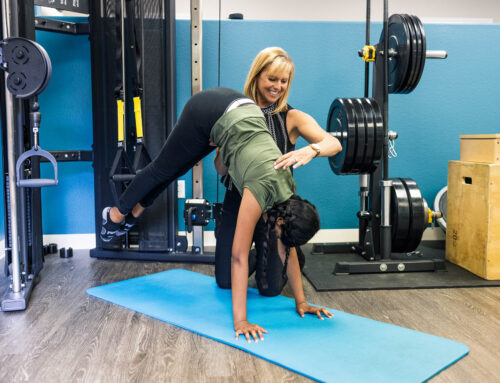Giving birth is traumatic for a woman’s body; even when there are no complications. That’s why, regardless of a natural birth or a c-section, I recommend for all new moms to come in for an evaluation six to eight weeks after giving birth to create a plan for their postpartum healing.
The two most common conditions we treat after childbirth are pelvic floor issues and diastasis recti. Pelvic floor issues range from painful intercourse to incontinence. After giving birth women can present with either a “tight” pelvic floor or “weak” pelvic floor.
Diastasis recti is when the midline of your stomach muscles separates significantly during pregnancy and has a hard time coming back together after delivery. This can create a protruded abdomen and causes instability because of the weakened abdominal muscles.
What is the Pelvic Floor and What is a Pelvic Floor Condition?
Your pelvic floor is a “sling” of muscles (think of a small hammock) that runs between the pubic bone in the front, and the tailbone at the back. A woman’s pelvic floor muscles support her uterus, bladder, and colon. Oftentimes you will hear “tight” or “weak” when referring to the pelvic floor. This is a misnomer. Both can be weak. Tight is not the same as strong. Tight means there is a lot of tightness and shortening of muscles that need to be relaxed and reintegrated into the core to work properly.
A more correct definition is hypertonic vs. hypotonic.
A hypertonic pelvic floor will be too tight and the patient will have difficulty contracting the pelvic floor muscles. Signs that you may be struggling with a pelvic floor that is too tight are:
- Difficulty starting to pee or having a “2nd pee” (you think you’re done and stand up and more comes out)
- Constipation
- Pain with intercourse
- Increased UTI risk
- Leaking with sneezing, coughing, jumping or heavy lifting
- Feels like you can’t get a good contraction or it feels weak when you do
It is common that postpartum women have a tight pelvic floor, but again, tight does not mean strong. It means that there is a lot of tension in the area from the trauma of childbirth. Additionally, the pelvic floor gets tight because it is doing double duty trying to keep the body stable and upright while your abdominal muscles heal and come back to a pre-pregnant state. Tight pelvic floors are more common with vaginal deliveries and if there was an episiotomy or any tearing.
A hypotonic pelvic floor means the patient has decreased muscle tone and those muscles are actually “turned off”. Signs that you may be struggling with a “weak” pelvic floor are:
- Leaking with sneezing, coughing, jumping, heavy lifting
- Tampons falling out
- A heavy feeling
- Sex “doesn’t feel like it used to before kids”
- Difficulty finding pelvic floor and connecting to those muscles
What is Diastasis Recti and How Do I Know if I Have it?
Every woman has diastasis recti when they are pregnant. It is a natural process your body goes through to separate your abs to make room for growing uterus and baby. As the baby grows the organs are shifted upward which will expand your rib cage; that expansion of the rib cage is why some women go up a bra size when they are pregnant! This is also why you become short of breath while pregnant as the diaphragm can no longer be utilized properly.
Some women’s bodies return to their pre-pregnant state on their own, but a good percentage do not and need support to bring those muscles back into place. Typically, new moms notice that there is an issue with their ab muscles not healing three to six months postpartum. If you think you are suffering from diastasis recti, there are a few things you should look out for.
- A distention in the belly, especially at the center where the abs should meet (mom pooch)
- Feeling like your abs are separated and that you have no support in your core
- Feeling like your insides could easily fall out
- Cannot get your core engaged
- Have tried ab workouts but cannot get stronger
The rectus abdominus or the “six pack” muscle is the muscle that separates to make room for baby and organs while pregnant. This muscle is connected by connective tissue called the linea alba. Depending on how separated that muscle is, the more pronounced your diastasis recti will be. When checking for a diastasis, it is important to note both the separation width and how much tension the linea alba produces (do your fingers keep sinking in or does it feel like bouncing on a trampoline?).
Diastasis Recti and Pelvic Floor Recovery with Breathing
Both diastasis recti and pelvic floor issues are a whole-body problem. The most effective recovery exercises for both are proper breathing techniques. I work with new moms to retrain their breathing system to get the diaphragm back on board and engage with the pelvic floor. This also helps to fire the abdominal muscles to get them engaged. If the diaphragm does not fully function, then the abdominal muscles can’t either. It is all connected.
Getting a good inhale down into the pelvic floor can really help in the healing process for a “tight” pelvic floor. Whereas a good exhale can assist in the healing process for a “weak” pelvic floor, while working in conjunction with other exercises. Breathing is key and will be integrated in all exercises as being able to breathe through movement is what gives us dynamic stability, i.e. doing everyday activities. Getting a good inhale or exhale is dependent on diaphragm function and rib cage expansion, both of which are disrupted during pregnancy.
At our clinic, I teach women these breathing exercises so they can do them at home. One exercise we do is sidelying breathing which helps restore the core by improving diaphragm function.
Breathing is so important in recovery of diastasis recti and helpful in reducing tightness in the pelvic floor and/or getting the pelvic floor to start working correctly. I have seen such incredible results from this breath work, including my own postpartum recovery, that I am currently getting certified as a Postpartum Corrective Exercise Specialist (PCES); giving me even more tools to rehabilitate postpartum women after giving birth.





